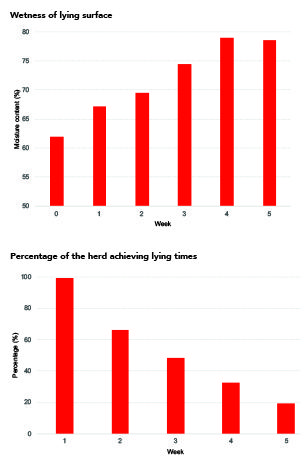Your cows need enough dry space to lie down – Karen Trebilcock explains why.
If cows were allowed to sit around the management table and plan their own wintering they would tell the farm team that they need to be able to lie down, says DairyNZ animal care team leader Helen Thoday.
It can often be hard to pick up from the stoic animals that they need space and, although farmers understand that good quality feed, clean water and the right minerals are essential, DairyNZ is now focusing on spreading this message, she says.
“Cows can sleep and ruminate standing up but prefer to do it lying down. Every animal needs to lie down to rest and that includes cows. In fact, I can’t think of a mammal that doesn’t lie down.”
New Zealand’s Dairy Cattle Code of Welfare states that dairy cattle should have at least eight hours of lying time every day. Helen says that in New Zealand’s pasture-based systems cows have the best opportunity to express their natural behaviors, and one of these was to lie when they want, where they want, and with the herd mates they want.
 Most of the year this is not a problem but when ground conditions become wet and cold, cows choose not to lie down even when their bodies need it the most.
Most of the year this is not a problem but when ground conditions become wet and cold, cows choose not to lie down even when their bodies need it the most.
“Farmers need to make sure they give their cows adequate, comfortable opportunities to lie down.
“Cows have small feet and large bodies and their growing foetus in winter weighs more than 15kg plus the fluids around it.
“By calving time there is an extra 30 plus kilos being supported by the cow’s feet.”
But however much a cow needs to lie down, if it’s in wet mud she can refuse to do it for days until she becomes exhausted. When she is finally given access to a dry lying area she will choose lying down over eating.
“We know cows are highly motivated to lie down from several studies carried out around the world,” says Helen.
A 2018 study by the University of California and Aarhus University in Denmark showed cows would push a gate that weighed up to 40% of their own body weight to access an area with deep bedding rather than lie down on concrete slats.
When the gate was weighted more and was impossible for them to push open, some of the cows still tried to open it up to 39 times. One cow eventually lay down on the slats with its head in the weighted gate.
After a day of not being able to get through the gate the cows were allowed free access again to the bedding and instead of lying on it for the usual eight hours they lay on it for 18 hours and reduced their time eating by a third.
Other studies here and overseas show that cows in wet conditions and exposed to bad weather used body fat to meet energy requirements and were less likely to eat their daily break. White blood cell counts were also reduced making them more susceptible to infections such as mastitis and lameness.
However, the daily signs that cows weren’t lying down were subtle and could be hard to see.
“A cow will move its weight from leg to leg if it has been standing for a while but usually when someone is there the cows are walking around, excited about getting fed,” Helen says.
If you see cows lying down, make sure they are stretched out on the ground as they do in summer.
Studies have shown cows lie differently in cold mud – they will tuck their legs under themselves, limiting the amount of their bodies touching the ground.
Calving in mud is equally bad for cow health and the health of the calf.
Calves quickly get cold on wet surfaces and can fail to stand and feed for the first time.
As well, cows calving in mud can’t easily stand and lie down repeatedly as is normal during labour.
“Cows that are afraid of slipping over won’t get up so they will spend what can be hours calving lying down.
“Because of this their legs get cold in the wet mud and after the calf is born they sometimes can’t get up again because their legs are so cold.
“Using an infrared camera Dairy Australia found the temperature of the cow’s hamstrings after calving in wet mud was down at 11 degrees C when they should have been at body temperature.
“If the cow can’t get up after calving then the calf won’t be able to feed and get the colostrum it requires.”
Helen says farmers need to assess winter paddocks daily as they are eaten and make sure cows have dry ground to go to.
“When the paddocks get sloppy wet and there is a storm coming, or more rain is forecast, you have to act because you know it’s not going to get any better.
“Look for what we call the tide mark – the line of mud on its coat that shows the cow has been trying to lie down in the mud. We don’t want to see any of those.
“If your cows have a tide mark then act straight away. Give them somewhere drier to lie down.”
If your cows are:
- Sitting with their legs tucked under them
- Have a ‘tide’ mark on their coats
- Or are not lying down a couple of hours after eating their break
ACT STRAIGHT AWAY
• For more information go to dairynz.co.nz/wintering





